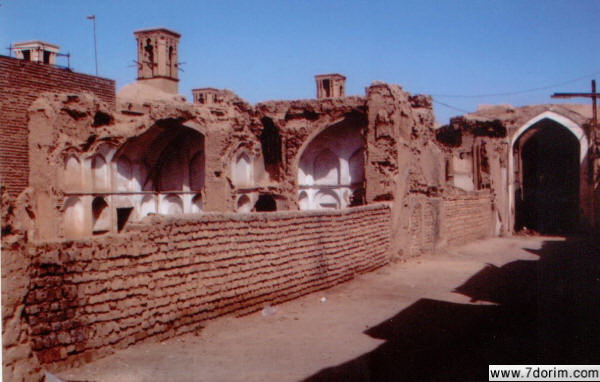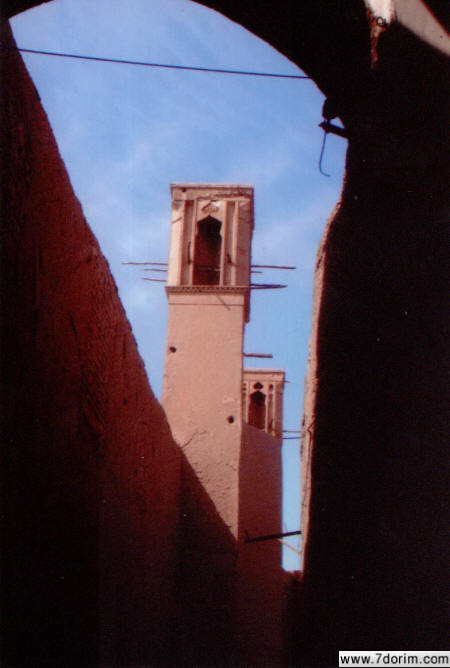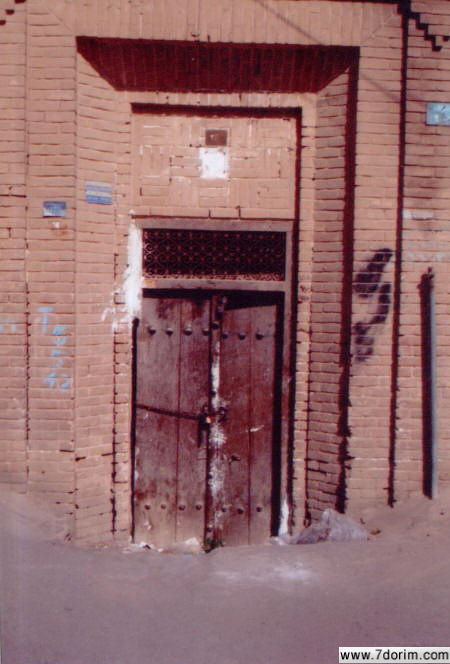One account suggests that the migration of Jews to Kashan is primarily associated with the era of the Inquisition in Europe (15th century AD). This coincided with their expulsion from Spain and the subsequent forced migration of a significant number to Iran, where they settled in Kashan. Additionally, the dialect spoken by Kashani Jews, particularly those in villages, hints at a historical lineage dating back to the early 13th century, aligning with the Seljuk period.

Kashan has long been a major trade center and one of the most populous Jewish cities. Its Jews thrived in business and generally lived in relative prosperity. Later, the migration of Jews to Kashan further increased due to the silk trade’s boom during the Safavid period, so much so that their population in the Qajar era reached over seven thousand people, even though a large number had been forced to convert over the preceding centuries. The Jews of Kashan, like those in other cities, had experienced various ups and downs throughout history, perhaps one of the most significant being during the Safavid period (early 17th century) under Shah Abbas II’s reign, when they faced severe persecution and discrimination.
After the exiled Jews migrated and Spanish rabbis arrived in the 15th century, Kashan saw the establishment of the Beit Hamidrash—a hub for cultural and religious activities. This period marked a significant upsurge in Jewish cultural and religious vitality in the city. However, this flourishing period was short-lived, as it dwindled with the onset of the second half of the Safavid era.
Shortly after Shah Abbas II assumed the throne, ominous changes unfolded for the Jewish community in Kashan. They were subjected to a mandatory seven-year conversion period, marking the onset of widespread anti-Semitism in Iran. Many Kashani Jews were coerced into converting to Islam. However, some affluent converts managed to reclaim their Jewish faith with the assistance of a Shiite scholar, Mullah Mohsen Fayz Kashani, by paying the jizya tax.
In his poetry, the Jewish poet and historian known as “Babai ibn Lotf,” born in Kashan, recounted a challenging period for the Jewish community. Under duress, they found an unexpected ally in Mullah Mohsen Fayz Kashani, a distinguished Shia scholar and ayatollah of the 11th century AH.
Mullah Mohsen reached out to the Jews, highlighting his close ties to Shah Abbas II. He assured them of his influence, mentioning that even during the Shah’s visits to Kashan, the Shah stands behind Mullah Mohsen to lead the prayer. With sincerity, Mullah Mohsen pledged to address the oppression facing the Jewish community directly with the Shah.
As “Babai ibn Lotf” eloquently expressed in his verses, Mullah Mohsen Fayz Kashani remained true to his word. Through his intervention, the persecution against the Jews in Kashan notably lessened, offering them a reprieve from the injustice they endured.-
Scholars of Persian Jewry value the importance of the contents of Babai ibn Lotf’s books, especially the book “Vaghaye’ Nameh” (i.e. Chronicle of Events). This comprehensive account vividly depicts the challenges faced by Jews during the Safavid era, while also highlighting their social cohesion, organizational structures, and religious affiliations, particularly within the Jewish community of Anousi Kashan. It delves into various aspects, including livelihoods, social interactions with the Muslim population of Kashan, and the migration of Jews from Kashan to Ottoman territories. Additionally, it provides valuable insights into significant historical events of the period.
Another Jewish poet of Kashan is Mullah Benjamin ben Mullah Mishael, known as “Emouna”. He is actually considered the first pioneer Jewish poet in Iran, a role model for other Jewish poets such as Shahin and Omrani who have spent their lives versifying religious books. “Emouna” is from the 18th century (1632-1732). He had great respect and value among the literary circles and Muslim scholars of Kashan. He has versified the books Harut, the laws of the Jews and also Yusuf and Zulaikha. It is said that he also wrote a poem in praise of Ashraf Afghan. His longest poem is “Aghidat-e Eshagh” (i.e. The Belief of Isaac), which has about three hundred verses and narrates the story of the sacrifice of Isaac in an epic language. His other works include: “Ehtezarnameh” (i.e. Letter of Caution), “Monajatnameh” (i.e. Letter of Supplication), “Purim”, “Davazdah Asbat” (i.e. The Twelve Tribes), “Sargozasht-e Aminah ba Hamsarash” (i.e. The Story of Emouna and His Wife), and “Delsard Shodan Az Zanan” (i.e. “Disheartenment from Women”).

Kashan has been a fertile ground for poets and scholars throughout history. Among the notable figures to emerge from this city are:
- Dan Shmuel
- Babai ibn Farhad
- Shmuel Pirahmad
- Benjamin ben Eliyahu
- Sarmad Sufi
- Rabbi Yehuda ben Eleazar, a philosopher and jurist renowned for his valuable book (Huvot Yehuda)
- Yehuda Lari
Additionally, the illustrious artist and musician of the Qajar era, Musa Khan Kashi, stands among these great names.
Famous physicians have risen from Kashan and spread around the world, some of which include:
- Hakim Harun
- Hakim Noor Mahmoud
- Haki
- m Aflatoun
- Hakim Yaghoub
- Loghman Nahoraii, member of the National Consultative Assembly from the second to the thirteenth term
- Murad Aryeh, representative of the fifteenth, eighteenth, nineteenth and twentieth terms of the National Consultative Assembly
- The Ghermezian family, one of the largest capitalists in Canada
- Rabbi Yedidia Shofet, the famous jurist and religious leader of Iranian Jews, and his son, Rabbi David Shofet
- Lord David Alliance, religious leader of Iranian Jews in America and one of the largest textile industrialists in England
Kashan holds a significant place among Iran’s religious cities. Its cultural and religious vitality is intricately linked to the migration of Sephardic Jews from Spain during the 15th century AD. In particular, the arrival of religious and Rabbinate figures (religious authorities) left an indelible mark on the dissemination of religious knowledge. The observance of religious practices and the safeguarding of Jewish law in Kashan surpassed that of many other Jewish communities, such that it became known as “Little Jerusalem” (Yerushalem Ghatan).
Talking of Sephardic influence, the manner in which the Tefillah (prayer) is read and the Torah is recited on Shabbat is deeply rooted in the rhythm and melody that is used by Sephardic Jews, a practice upheld for generations in Europe.

The heart of Kashan’s Jewish community was primarily centered in seven areas known as:
- Mohtasham Alley
- Darb Kalan Alley
- Paderakht Alley
- Darb Zanjir Alley
- Paghian Alley
- Sarpol Alley
- Zarrabkhaneh Alley
Each alley housed one or two synagogues (until the early 1950s), totaling eleven synagogues:
- Mahaleh Synagogue
- Mullah Synagogue
- Haji Yadegar Synagogue
- Rabbi Elias Synagogue
- Solomon Synagogue
- Amusheh Synagogue
- Javid Synagogue
- Paniriha Synagogue
- Hakim Yahya Synagogue
- Asher Synagogue
- Mullah Mikhael Synagogue
Following the establishment of the Pahlavi government, the Jewish community in Kashan gradually relocated to Tehran seeking greater liberties, improved business prospects, and enhanced educational opportunities for their children. Consequently, prior to the Islamic Revolution, the Jewish population in Kashan dwindled to merely fifteen families.
Presently, Kashan stands devoid of any Jewish residents. Except for one or two synagogues, both in ruin, the city bears no evidence of its once vibrant Jewish presence. Notably, the Jewish cemetery in Kashan, adorned with tombstones dating back over a century, serves as a poignant historical landmark.
The shrine of Mullah Moshe Halavi attracts Jewish and Muslim pilgrims from all corners of Iran annually, reflecting its profound reverence among both communities. Even the Muslims of Kashan hold this cleric in high esteem, acknowledging the virtues associated with him. Renowned as one of Iran’s preeminent Jewish legal authorities, Mullah Moshe Halavi was one of the greatest Jewish jurist in Iran. This Kabbalist scholar authored the book “She’elot u Teshuvot” (i.e. worship and religious response).
